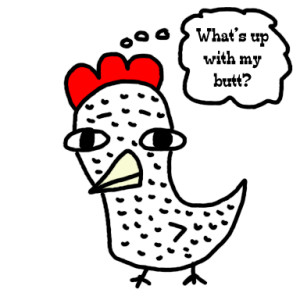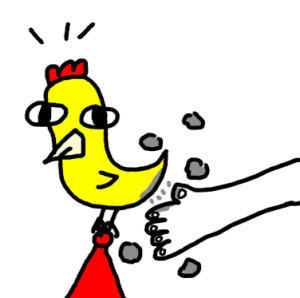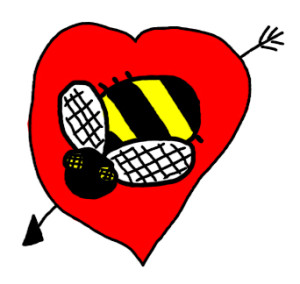Chickens And Mites
Henny Penny has a naked butt. At first I suspected that it was from butt pecking. Suzy Creamcheese Junior shortly thereafter lost a bunch of butt feathers, and I even saw wounds on her butt that totally looked like pecking wounds. I was putting Blukote on the affected butts, which is an antiseptic, and is supposed to stop butt pecking. But the butt feathers continued to disappear, and/or not grow back. Then I noticed that one of the Mandrell Sisters was starting to lose butt feathers too. So I either had a rampant butt pecker on the loose, or this was something else. And the something else that it probably was was probably mites. The story you’re about to hear will make you very itchy.
I recently thought Steve had vent gleet. She may still have had it. I almost hope so, otherwise I put her through the epsom salt drink ordeal for nothing (see last week’s post for more details on the epsom salt drink ordeal). But she had a poopy butt, and in my experience, that means vent gleet. However, it turns out that having a poopy butt can also be a sign of having mites. So I had thought that I had chickens with multiple butt ailments, and only when I looked at the big picture did I see what was really happening. There may not be a phantom butt pecker on the loose after all, just a ton of tiny butt biters.
Mites can be very hard to see, but I thought I’d look for them anyway. When the ladies were resting on the roost at night, I grabbed a Mandrell, and gazed deeply into her featherless butt area. I did see tiny dark spots on her skin. They didn’t move, like mites often do, but they also didn’t look like they should be there. It was time to treat for mites, just in case. The “good” news is that like everything to do with chickens, there are a million opinions about how to treat this. One was to use diatomaceous earth in the coop to kill the mites. That was lucky, because I have a bunch of diatomaceous earth. I sprinkled it in their bedding, and waited. Turns out I wasn’t sure what I was waiting for, so a few nights later, I went in and patted some onto each of their butts, just to make sure it got where the little nasties were.
People often complain that diatomaceous earth is bad for the respiratory systems of everyone who comes in contact with it. This may be true. Others say this is why you should use Sevin dust instead of diatomaceous earth, but if you read the label, Sevin is 95% diatomaceous earth, plus some poison. It also apparently is terrible for bees, and I am a big supporter of bees, so I crossed that cure off my list. The next thing I heard about was called “poultry powder.” This seemed to be the thing that people who didn’t like Sevin recommended. It’s also a poison, but allegedly less dangerous than Sevin, so I ordered some of this just to hedge my bets. Then I got it, and on the label it says it too is bad for bees, but only if you put it on flowers bees are pollinating. I wasn’t doing this, and there are no flowers near the coop, so hopefully no bees died in the treating of my chickens. However, chickens can die from mite infestations, so it was important for me to get this sorted out. I did the same thing with the poultry powder that I did with the diatomaceous earth. I snuck in at night, patted some on the infested butts, and hoped for the best.
One dose won’t do it. I have to repeat this procedure in 10 days, since the powder doesn’t kill the eggs, just the live mites. So in 10 days the mite eggs will hatch, and then I’ll get those mites too, I hope. I also cleaned all the bedding out of the coop, washed the entire coop in vinegar, and let it air out. It smelled like a salad for a while, but who doesn’t like salad? I’m not sure how I’ll know if the mites are defeated, since feathers can take a while to grow back. This may be a slow process. I guess I’ll repeat the treatment as needed until I see butt feather regrowth occurring. I suppose I have all summer, huh? This is not the vacation I was hoping to take, but maybe with the right amount of marketing, butt mite excursions will take off. Another million dollar idea from my chickens’ hinders.
(CREDITS: Theme music: Chicken In The Barnyard by Fireproof Babies, Music bed: Guatemala – Panama March by Heftone Banjo Orchestra)
Tags: backyard chickens, chickens, diseases, Erik P. Kraft, hipster farming, mites, parasites




